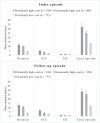Comparison of the accuracy of classification models to estimate healthcare use and costs associated with COPD exacerbations in Saskatchewan, Canada: A retrospective cohort study
- PMID: 30996632
- PMCID: PMC6422214
Comparison of the accuracy of classification models to estimate healthcare use and costs associated with COPD exacerbations in Saskatchewan, Canada: A retrospective cohort study
Abstract
Objective: COPD is a high-cost disease and results in frequent contacts with the healthcare system. The study objective was to compare the accuracy of classification models with different covariates for classifying COPD patients into cost groups.
Methods: Linked health administrative databases from Saskatchewan, Canada, were used to identify a cohort of newly diagnosed COPD patients (April 1, 2007 to March 31, 2011) and their episodes of healthcare encounters for disease exacerbations. Total costs of the first and follow-up episodes were computed and patients were categorized as persistently high cost, occasionally high cost, and persistently low cost based on cumulative cost distribution ranking using the 75th percentile cutoff for high-cost status. Classification accuracy was compared for seven multinomial logistic regression models containing socio-demographic characteristics (i.e., base model), and socio-demographic and prior healthcare use characteristics (i.e., comparator models).
Results: Of the 1182 patients identified, 8.5% were classified as persistently high cost, 26.1% as occasionally high cost, and the remainder as persistently low cost. The persistently high-cost and occasionally high-cost patients incurred 10 times ($12 449 vs $1263) and seven times ($9334 vs $1263) more costs in their first exacerbation episode than persistently low-cost patients, respectively. Classification accuracy was 0.67 for the base model, whereas the comparator model containing socio-demographic and number of prior hospital admissions had the highest accuracy (0.72).
Conclusions: Costs associated with COPD exacerbation episodes are substantial. Adding prior hospitalization to socio-demographic characteristics produced the highest improvements in classification accuracy. Accurate classification models are important for identifying potential healthcare cost management strategies.
Keywords: chronic obstructive; cost analysis; healthcare costs; logistic models; longitudinal studies; pulmonary disease.
Figures
Similar articles
-
Identifying Distinct Healthcare Pathways During Episodes of Chronic Obstructive Pulmonary Disease Exacerbations.Medicine (Baltimore). 2016 Mar;95(9):e2888. doi: 10.1097/MD.0000000000002888. Medicine (Baltimore). 2016. PMID: 26945376 Free PMC article.
-
A new method for examining the cost savings of reducing COPD exacerbations.Pharmacoeconomics. 2010;28(9):733-49. doi: 10.2165/11535600-000000000-00000. Pharmacoeconomics. 2010. PMID: 20799755
-
Cost effectiveness of budesonide/formoterol added to tiotropium bromide versus placebo added to tiotropium bromide in patients with chronic obstructive pulmonary disease: Australian, Canadian and Swedish healthcare perspectives.Pharmacoeconomics. 2011 May;29(5):403-14. doi: 10.2165/11590380-000000000-00000. Pharmacoeconomics. 2011. PMID: 21504240
-
The economic impact of exacerbations of chronic obstructive pulmonary disease and exacerbation definition: a review.COPD. 2010 Jun;7(3):214-28. doi: 10.3109/15412555.2010.481697. COPD. 2010. PMID: 20486821 Review.
-
Economic aspects of antimicrobial therapy of acute exacerbations of COPD.Respir Med. 2007 Jan;101(1):15-26. doi: 10.1016/j.rmed.2006.03.030. Epub 2006 May 2. Respir Med. 2007. PMID: 16650975 Review.
Cited by
-
An economic evaluation of chronic obstructive pulmonary disease clinical pathway in Saskatchewan, Canada: Data-driven techniques to identify cost-effectiveness among patient subgroups.PLoS One. 2024 Apr 1;19(4):e0301334. doi: 10.1371/journal.pone.0301334. eCollection 2024. PLoS One. 2024. PMID: 38557914 Free PMC article.
-
Increasing Prevalence and Direct Health Care Cost of Inflammatory Bowel Disease Among Adults: A Population-Based Study From a Western Canadian Province.J Can Assoc Gastroenterol. 2021 Mar 16;4(6):296-305. doi: 10.1093/jcag/gwab003. eCollection 2021 Dec. J Can Assoc Gastroenterol. 2021. PMID: 34877469 Free PMC article.
-
Real-World Cost-Consequence Analysis of an Integrated Chronic Disease Management Program in Saskatchewan, Canada.Health Serv Insights. 2024 Jan 10;17:11786329231224621. doi: 10.1177/11786329231224621. eCollection 2024. Health Serv Insights. 2024. PMID: 38223214 Free PMC article.
References
LinkOut - more resources
Full Text Sources
Miscellaneous

